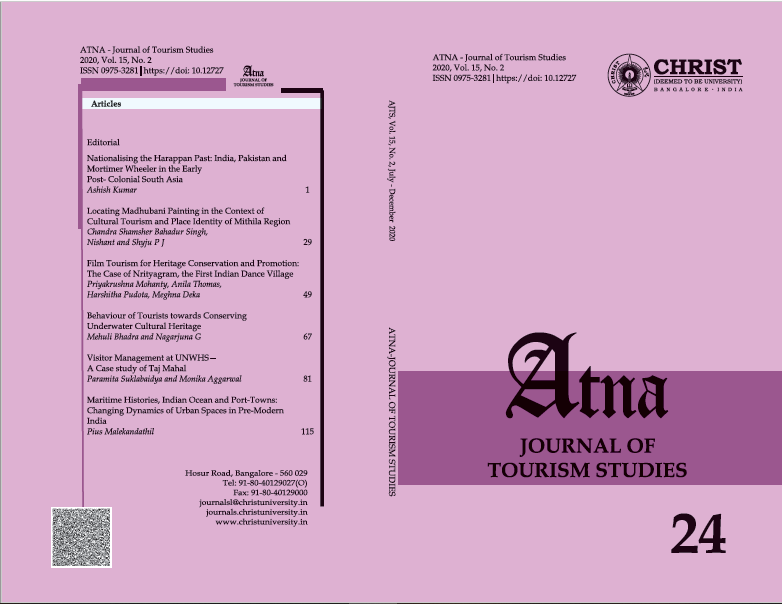Locating Madhubani Painting in the Context of Cultural Tourism and Place Identity of Mithila Region
DOI:
https://doi.org/10.12727/ajts.24.2Keywords:
Madhubani painting, Mithilanchal, traditional art, art heritage, cultural tourismAbstract
Art is often a reflection of culture and is considered to be the repository of a society’s collective memory. Researchers have long been interested in the relationship between art and culture. Art also has utilitarian influences on society and the times in which it is created in a cultural space is considered an integral component of culture. Different forms of art represent the diverse expressions of creative ideas in visual formats or performances that in turn, become an identity of a place. Madhubani paintings developed in the Mithilanchal region of Bihar are the perfect example of traditional art that maintained continuity through generations in the course of time and was assimilated gradually into the region's cultural setting. The tourism industry in India heavily banks on cultural tourism, and several communities have received a facelift by promoting places which are interesting for their heritage. Madhubani and nearby places in Bihar have a great tradition of paintings where visitors can find the authentic experience of these rich cultural features. The present study investigates the art tradition of Madhubani paintings, examining the challenges paused by commercialization and examining the scope of cultural tourism in the region.
References
Archer, W. (1949). Mithila Paintings. Marg, 3(3), 24-33.
Chattopadhyay, K. (1995). Handicrafts of India. New Delhi: ICCR & New International Publishing.
Heinz, C. (2008). Documenting the Image in Mithila Art. Visual Anthropology Review, 22(2), 5-33. doi: https:// doi.org/ 10.1525/ var.2006.22.2.5
Jain, J. (1997). Ganga Devi: Tradition and Expression in Mithila Painting. Ahmedabad: Mapin Publishing Pvt. Ltd. & the Mithila Museum.
Jain, J. (1995). The Bridge of Vermillion: Narrative Rhythm in the Dusadh Legends of Mithila in Indian Painting: Essays in Honour of Karl J. Khandalavala, B.N. Goswamy and Usha Bhatia (eds.) (pp. 207-22). New Delhi: Lalit Kala Akademi.
Jha, K. (2018). Mithila Gauravshalini. Patna: Amrit Prakashan.
Jha, N. (2014). Mithila Rising. Delhi: Sasta Sahitya Mandal Publications.
Jha, P. (2013). MithilakSamajikItihas. Madhubani: SahityikiPrakashan.
Lal, R. (2008). MithilakSanskritik Parampara. Janakpurdham: Ramanand Yuva Club.
Mishra, S. (2010). Mithila ke Mandir, GarhevamPuratatv. Satlakha: Damodar Publications.
Narendra, J. (2020). Vikas o Arthtantra. Ghaziabad: AntikaPrakashan.
Nepal Tourism Board. (2009). JANAKPURDHAM: The land steeped in Mythology. Kathmandu: NEpal Tourism Board.
Pritam Kumar, G. (2018). Brahmanical Intellectual Traditions: Making of Medieval Mithila. International Journaof Of Innovative Knowledge Concepts, 6(5), 125-131.
Pupul, J. (1989). The Earth Mother. New Delhi: Penguin.
Singh, M. (2004). Journey into distant land: Poetics of Mithila painting. Indian Folklife, 3(4)(17), 11-14.
Thakur, U. (2011). MithilakItihas. Patna: Maithili Akadami.
Thakur, V. (2016). Mithila – Maithili : A Historical Analysis. Patna: Maithili Academy.
Timothy, D. (2011). Cultural Heritage and Tourism: An Introduction. London: Channel View Publications.
UNWTO. (2018). Tourism & Culture Synergies. Madrid: UNWTO.
Vishwas, M. (2005). Cultural Tourism Management. Udaipur: West Zone Cultural Centre.
Verrier, A. (1967). Folk paintings of India. New Delhi: Inter-national Cultural Centre.
Online resources
Ghosh, S. Madhubani Painting, Vibrant Folk Art of Mithila. (2020). Scinetific Research Publishing, Retrieved 18 December 2020, from https://www.researchgate.net/publication/340689226_Madhubani_Painting-Vibrant_Folk_Art_of_Mithila
History of Mithila Painting - eMithilaHaat. (2020). Retrieved 15 December 2020, from http://www.emithilahaat.com/what-is-mithila-painting/
Madhubani (Mithila) Painting - History, Designs & Artists. (2020). Retrieved 18 December 2020, from https:// www.culturalindia.net/indian-art/paintings/madhubani.html
Mithila Painting: A Brief History of Traditional Art Form of North Bihar | NewsClick. (2020). Retrieved 19 December 2020, from https:// www.newsclick.in/mithila-painting-a-brief-history-of-traditional-art-form
Mithila Paintings - The Evolution of an Art Form. (2020). Retrieved 20 December 2020, from http://www.mithilapaintings-eaf.org/ welcome.html
Singh, CSB. (2020). Madhubani Paintings: People’s Living Cultural Heritage. Retrieved 17 December 2020, from https:// www.ancient.eu/article/1527/madhubani-paintings-peoples-living-cultural-herita/https:// www.ancient.eu/article/1527/madhubani-paintings-peoples-living-cultural-herita/

Downloads
Published
How to Cite
Issue
Section
License
Copyright (c) 2021 Atna Journal of Tourism Studies

This work is licensed under a Creative Commons Attribution-NonCommercial 4.0 International License.

